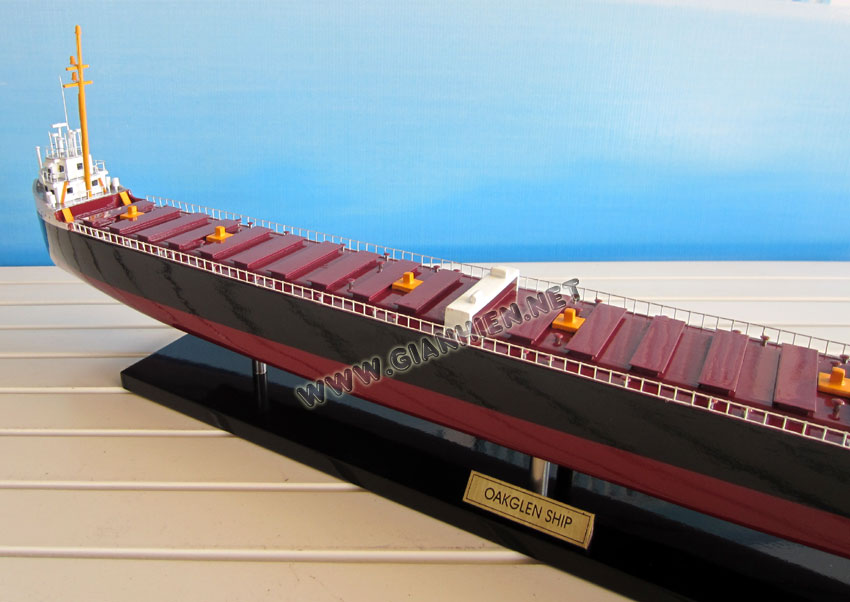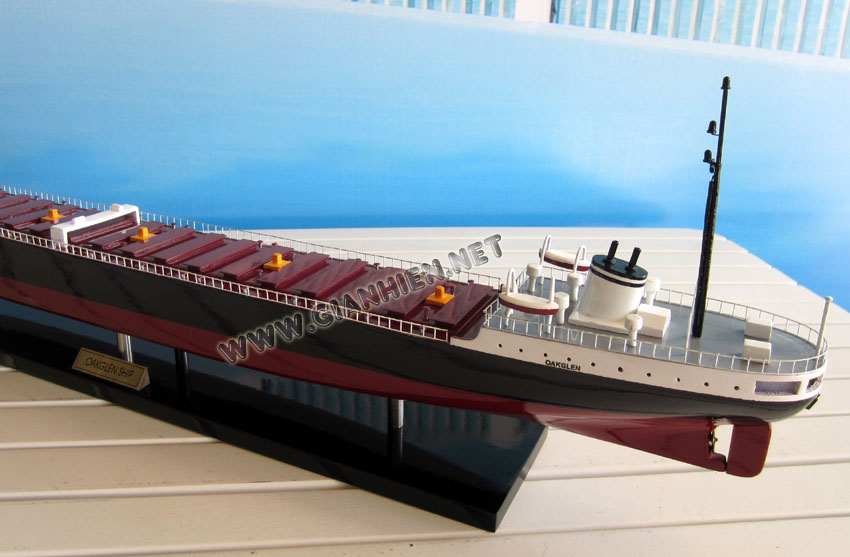|
This
traditional styled straight-decker was launched November 7,
1953 as the T. R. McLagan for Canada Steamship Lines,
Montreal, PQ (CSL). She was the last vessel built by Midland
Shipyards Div., Canadian Shipbuilding and Engineering Co.,
Midland, ON (a CSL subsidiary company). The shipyard ceased
operations shortly after the T. R. McLagan's launch. The
vessel's power is derived from a Westinghouse Electric Co.
8,500 s.h.p. steam turbine fed by two Foster Wheeler water
tube boilers burning heavy fuel oil giving her a maximum
service speed of 17.3 m.p.h. She is equipped with a bow
thruster. Her 21 hatches feed 6 holds where she can carry
22,250 tons at maximum Seaway draft of 26 feet and is
capable of carrying 22,950 tons at her maximum mid-summer
draft of 26 feet 7 inches.
The
vessel was named after Mr. T. R. (Rodgie) McLagan who had
come from Canadian Vickers in late 1951 to become the new
President of CSL. The T. R. McLagan departed on her maiden
voyage in the spring of 1954 when she sailed light to
Superior, WI to load 18,609 tons of iron ore on April 25th
for Hamilton, ON. Her cargoes would primarily consist of
grain products from various Great Lakes ports destine for
St. Lawrence River ports with return loads of iron ore.
Sailing on behalf of CSL, the T. R. McLagan set several
cargo records in her time. These records include 22,257 tons
of coal from Ashtabula, OH to Hamilton on August 1, 1954;
and a corn record of 22,256 tons from Duluth, MN to Montreal
set early in the Seaway era. Her ownership was transferred
to Canadian Shipbuilding and Engineering Co., Collingwood,
ON in 1968; and again in 1976 when it was transferred to
Pipe Line Tankers Ltd., Montreal, PQ. In both cases, Canada
Steamship Lines remained as managers.
The T.
R. McLagan was retired by CSL on November 3, 1984 at
Kingston, ON. She was then towed to Toronto, ON in October,
1987 to store soybeans. After a refit at Port Weller Dry
Docks, St. Catharines, ON in 1988, the T. R. McLagan
returned to service under charter to P. & H. Shipping Ltd.,
Mississauga, ON, a division of Parrish and Heimbecker; a
company well established in the grain business. P. & H.
Shipping was established in 1982 following the bankruptcy of
Soo River Company (Pierson Steamships Ltd.) on August 6,
1982. Soo River had been engaged by Parrish and Heimbecker
in carrying their grain cargoes for a number of years.
Following the charter, P. & H. purchased the vessel renaming
her Oakglen(2) while she was laid up at Goderich, ON during
the winter of 1989-90. The Oakglen(2)'s namesake is the
hardy "oak" tree with the common fleet suffix "glen". The
first vessel in this fleet to carry the Oakglen name was
purchased from the assets of the Soo River Company in
September 1983 as the J. F. Vaughn; being renamed Oakglen(1)
in October of that year. This vessel was built by the
American Ship Building Co., Lorain, OH and launched April
21, 1923 as the a) William H. Warner for Panda Steamship
Co., Cleveland, OH (G. A. Tomlinson, mgr.). Her dimensions
were 600' loa x 60' beam x 32' depth; 13,600 dwt, and
powered by a 2,200 horsepower triple expansion steam engine
fed by 3 coal-fired Scotch boilers. The vessel also bore the
names b) The International 1934-1977, c) Maxine 1977-1981,
d) J. F. Vaughn 1981-1983, and e) Oakglen(1) 1983 until her
scrapping in Turkey in 1989.
The
Oakglen(2) continued to sail for P. & H. Shipping serving
the parent company's grain elevators in ports such as Owen
Sound, ON and Goderich, ON with voyages to St. Lawrence
River ports with iron ore return loads until July 9, 2001.
At this point in her career, the Oakglen was the oldest
former CSL bulk steamer plying the Great Lakes; her record
on the lakes being unscathed by any serious reportable
incidents.
On
July 9, 2001; the Oakglen "returned to her roots". The
Oakglen and her fleet mate Mapleglen were purchased with
their contracts from P. & H. Shipping by Canada Steamship
Lines. This purchase gave CSL additional grain-carrying
capacity without having to commit their self-unloaders to
these loads. The Oakglen retained
her black hull but carried the CSL
colors on her stack. The acquisition marked the end of an
era in Great Lakes marine history and the renewing of an old
one as CSL returns to the bulker business. Oakglen
continued hauling seasonal cargoes of grain until entering
lay-up in Montreal on December 20, 2002. She remained in
lay-up and in 2003 was sold for scrapping.
On
October 17, 2003, the Oakglen was towed from Montreal by the
tugs Seaways 5 and Lac Vancouver heading for scrapping in
Alang, India. The Oakglen was paired with the Seaway Queen
at Quebec City, where the two tows were joined as one pulled
by the tug Seaways 5 for their trip to the scrap yard. The
tow took a Southerly route rounding the Cape of Good Hope to
escape the rough weather the North Atlantic dishes out that
time of year. The tug Seaways 2 with the Mapleglen in tow
reportedly took a severe beating in October transiting the
North Atlantic. A towing company spokesperson reported it is
more economical going this route with the two vessels in
tow, the Suez Canal will only allow one vessel per transit.
The scrap tow of the Oakglen and Seaway Queen ended February
11, 2004 with the safe arrival in Alang, India.
The
trip was not with out incident. The Seaway Queen experienced
flooding after rounding Cape Town, South Africa. Her rivets
started to pop and faced the threat of sinking. The salvage
tug pulling the vessels carried heavy duty salvage pumps.
These pumps kept the Seaway Queen afloat until her arrival
in Alang. The trip from Dubai to Montreal to Alang took
165 days.
Source: http://www.boatnerd.com |














